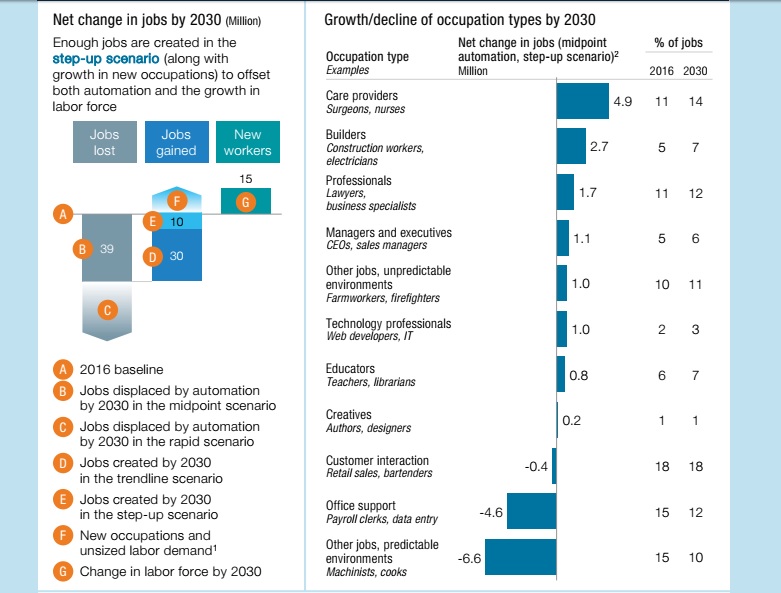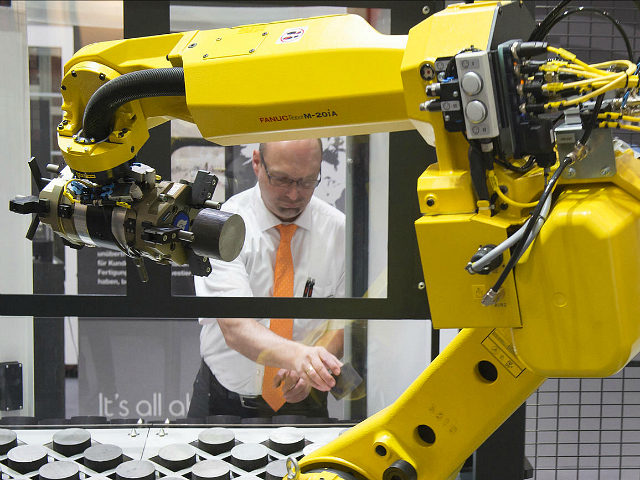American wage-earners are facing a tough future as a new study reveals that more than 30 percent of the nation’s workforce could lose their jobs to automation by 2030.
The study predicts that nearly 40 to 73 million American jobs will be lost by 2030 due to automation, and yet the government continues to annually provide green cards to one million legal immigrants and work permits to roughly one million foreign guest workers.
The job losses could shrink pay packets and widen the wealth gap, says the report. “Income polarization could continue in the United States and other advanced economies,” researchers stated in the study by the McKinsey Global Institute. “If reemployment [after job losses] is slow, frictional unemployment will likely rise in the short-term and wages could face downward pressure.”

from McKinsey Global Institute — “Jobs Lost, Jobs Gained: Workforce Transitions in a Time of Automation”
Every year, more than 1.5 million illegal and legal immigrants enter the U.S., often taking blue-collar working-class and middle-class American jobs. The current foreign-born population has now boomed to a historic high of roughly 44 million individuals in the U.S.
Many low-skilled American jobs are set to be replaced by automation in 15 years, but the U.S. has continued admitting hundreds of thousands of low-skilled, low-wage foreign workers through various visa programs, such as the H-2A and H-2B visas.
Additionally, more than 70 percent of the current legal immigration system is made up of foreign relatives of newly naturalized U.S. citizens coming to the country for no reason other than the fact that they have a relative in the U.S. This system, known as “chain migration,” has overwhelmed Americans for decades, as foreign grandparents, children, parents, cousins, and siblings have readily been able to enter the U.S. without the consideration of what impact their arrival would have on Americans.
Though legislation — such as the President Donald Trump-endorsed RAISE Act by Sen. Tom Cotton (R-AR) and Sen. David Perdue (R-GA) — would cut legal immigration in half in order to give relief to American workers, the GOP-led Congress has yet to champion the initiative.
For example, a potential chain migration of roughly ten to 19 million foreign nationals coming to the U.S. could be the result of an amnesty deal where 800,000 to 3.5 million illegal aliens who are enrolled and eligible for the President Obama-created Deferred Action for Childhood Arrivals (DACA) program are allowed to permanently stay in the country.
Americans seemingly oppose being replaced by both automaton and immigration, though it has not convinced the GOP-led Congress to take up the issues.
In polling by Pew Research Center, an astounding 85 percent of American said they favored restricting automation to doing jobs that are either dangerous or unhealthy for workers to do. A total of 47 percent of those Americans said they “strongly” favored the limitation on automation.
Additionally, 58 percent of Americans said there should be a limit on the number of American workers that businesses can replace with automation. Republicans, slightly more than Democrats, support limiting Americans being replaced by automation to only those jobs which are considered too dangerous or unhealthy for workers to do.
On immigration, a poll by Pulse Opinion Research revealed that 71 percent of Americans said businesses should be required to try harder to recruit and train from American demographic groups with the highest unemployment, rather than bringing in foreign nationals to take jobs.
Even if prices were to rise on products because they are made by Americans, rather than foreign nationals, 59 percent say it is better to raise wages to attract native workers in the U.S., instead of importing foreign workers to keep costs down.
The same poll revealed Americans’ desire to see overall legal immigration levels to the U.S. greatly reduced, as the change would bring about higher wages and stem the current trend of Americans being replaced in the workforce.
A total of 61 percent of Americans said they wanted to see the current inflow of legal immigrants reduced to 500,000 a year or even lower. Some 26 percent wanted to see legal immigration levels slashed to 250,000 new immigrants a year, just a sixth of the current immigration flow.
John Binder is a reporter for Breitbart News. Follow him on Twitter at @JxhnBinder.

COMMENTS
Please let us know if you're having issues with commenting.